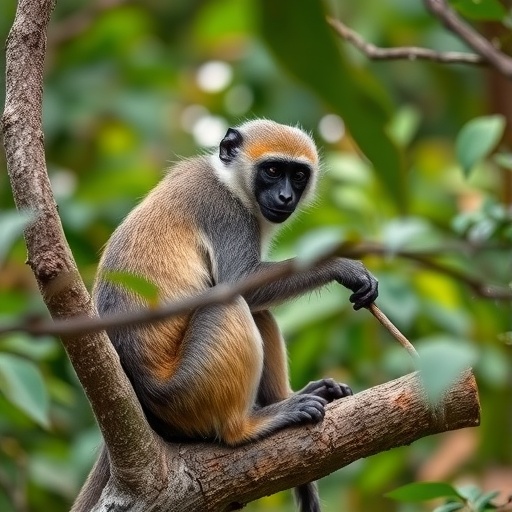In the intricate tapestry of human-animal interactions, few relationships can rival the nuanced dynamics between humans and wildlife, especially in biodiverse regions like Southwestern Ethiopia. A recent correction in a study has shed light on the pressing implications of forest loss and degradation on the coexistence of grivet monkeys and human populations in this ecologically rich area. This revelation brings to the forefront not only the challenges posed by environmental degradation but also the vital need for informed mitigation strategies to foster better cohabitation.
The research highlights that forest ecosystems are not merely backdrops to human activity; they are crucial habitats for countless species, including the grivet monkey, a primate known for its adaptability and social structure. The study’s authors stress that the decline in forest cover significantly disrupts the natural habitat of the grivet monkeys, leading to increased competition for resources and escalated human-wildlife conflicts. This trend is alarming, as it poses a dual threat to biodiversity and human livelihoods.
As forests shrink due to agricultural expansion, deforestation for timber, and urbanization, grivet monkeys are forced to encroach on human settlements in search of food and shelter. This encroachment often results in conflicts, where monkeys raid crops, leading to economic losses for local farmers. The authors of the study emphasize that understanding these interactions is critical for developing effective conservation strategies that consider both human needs and wildlife protection.
The research paper further elaborates on the socio-economic ramifications of wildlife displacement. As grivet monkeys adapt to human-altered landscapes, they often find themselves in precarious situations, leading to potential health risks, such as the transmission of zoonotic diseases. These risks highlight the necessity for a multidisciplinary approach to conservation, ensuring that public health considerations are integrated into wildlife management policies.
Another significant aspect discussed in the correction is the cultural importance of grivet monkeys to local communities. These animals are not merely wildlife to the inhabitants of Southwestern Ethiopia; they hold cultural significance and are often woven into local folklore and traditions. The loss of their natural habitat and subsequent changes in their behavior resonate deeply within the community, further complicating the human-wildlife interaction narrative.
Climate change also plays a pivotal role in this equation. As global temperatures rise and precipitation patterns shift, the habitats of grivet monkeys are impacted in unforeseen ways. Altered climates can lead to reduced food availability and increased pressure on already stressed ecosystems. The study suggests that proactive climate adaptation measures must be a part of any conservation strategy to mitigate these changing circumstances.
In addressing the challenges posed by habitat degradation, the authors propose a range of current mitigation strategies which can be employed. These strategies are not one-size-fits-all but should be tailored to the specific needs of local communities and wildlife populations. Community-based conservation initiatives can empower local people to engage in sustainable practices that benefit both their agricultural pursuits and the preservation of grivet monkeys.
Furthermore, educational outreach plays a crucial role in fostering understanding and tolerance between humans and monkeys. Initiatives that promote awareness about the ecological significance of grivet monkeys and the benefits of cohabitation can lead to more harmonious relationships. Such programs could illustrate how these primates contribute to the ecosystem and help enhance biodiversity, offering a more nuanced perspective on coexistence.
Innovative technologies may also provide new avenues for mitigating human-wildlife conflict. The integration of non-lethal deterrents, such as sound devices or barriers, can help protect crops from monkey raids while offering safe passage for wildlife. These technological solutions should be developed in conjunction with local communities to ensure effectiveness and acceptance.
The study underscores the importance of strong policy frameworks that support conservation efforts and balance human development with environmental sustainability. Policymakers are urged to recognize the interconnectedness of human and wildlife fates within forest ecosystems. By investing in sustainable land-use practices and reforestation efforts, policymakers can create a resilient landscape that benefits both communities and grivet monkeys alike.
Ultimately, the health of forest ecosystems is inextricably linked to the wellbeing of human populations. A collaborative approach that includes farmers, conservationists, and policymakers is essential for developing durable solutions to the challenges posed by forest loss and monkey-human interactions. These collaborative efforts not only pave the way for sustainable coexistence but also serve as a model for similar conflicts arising in other biodiverse regions across the globe.
This research serves as a timely reminder of the importance of addressing environmental challenges through an integrative lens, one that encompasses ecological integrity, social equity, and cultural values. As the world grapples with increasing environmental pressures, studies like this highlight the urgent need for coherent strategies that cultivate harmony between humanity and nature, ensuring that both thrive in a rapidly changing world.
In conclusion, the implications of forest loss and degradation cannot be understated. As we delve deeper into the complexities of human-grivet monkey coexistence, it becomes increasingly evident that proactive measures are needed to mitigate conflicts and foster resilience. Through education, innovative technologies, and robust policy frameworks, we can work towards a more sustainable future where both humans and wildlife can coexist harmoniously.
Subject of Research: The implications of forest loss and degradation on human-grivet monkey coexistence in Southwestern Ethiopia.
Article Title: Correction to: Implications of forest loss and degradation on human-grivet monkey co-existence: challenges and current mitigation strategies in Southwestern Ethiopia.
Article References:
Gemeda, D.O., Katebu, Y.G., Moisa, M.B. et al. Correction to: Implications of forest loss and degradation on human‑grivet monkey co‑existence: challenges and current mitigation strategies in Southwestern Ethiopia. Environ Monit Assess 197, 1052 (2025). https://doi.org/10.1007/s10661-025-14527-z
Image Credits: AI Generated
DOI: 10.1007/s10661-025-14527-z
Keywords: grivet monkeys, forest loss, human-wildlife conflict, conservation strategies, Southwestern Ethiopia, biodiversity, coexistence, ecological integrity, sustainable practices, community engagement.




